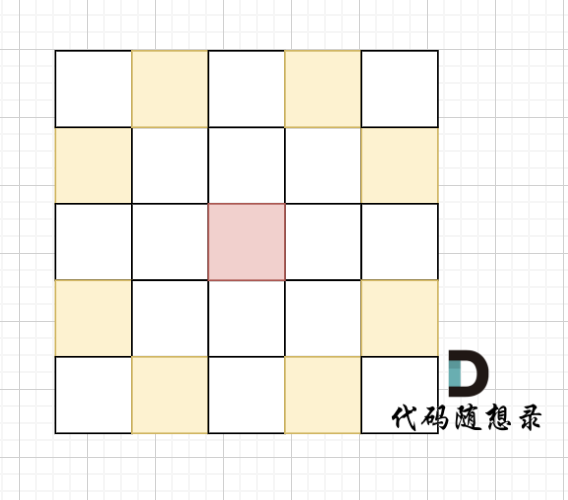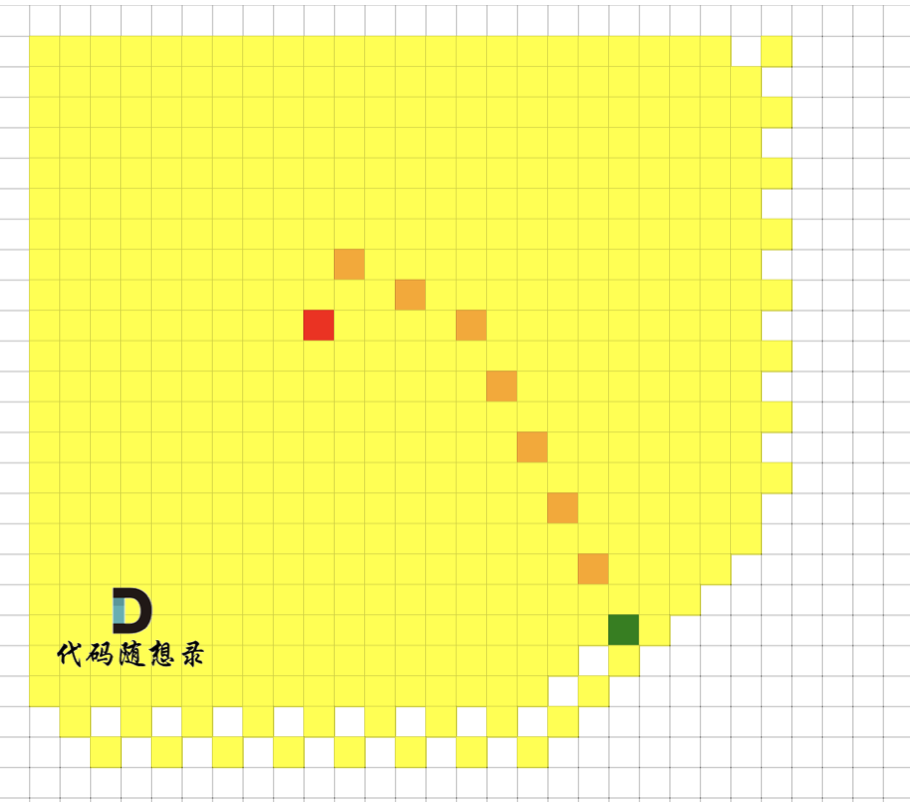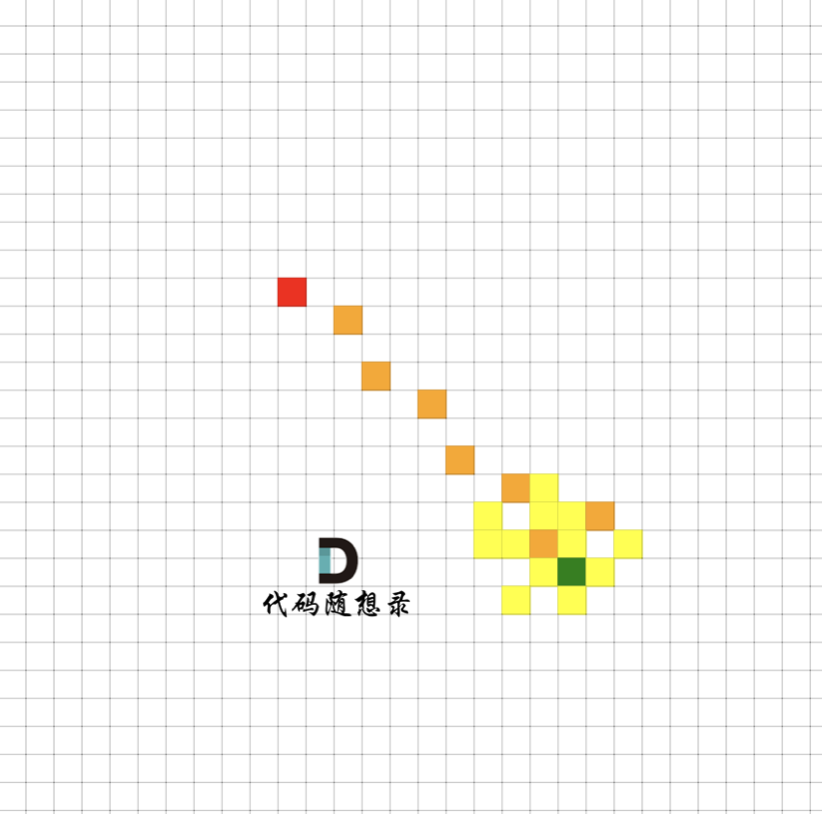题目描述
在象棋中,马和象的移动规则分别是“马走日”和“象走田”。现给定骑士的起始坐标和目标坐标,要求根据骑士的移动规则,计算从起点到达目标点所需的最短步数。
骑士移动规则如图,红色是起始位置,黄色是骑士可以走的地方。
棋盘大小 1000 x 1000(棋盘的 x 和 y 坐标均在 [1, 1000] 区间内,包含边界)
输入描述
第一行包含一个整数 n,表示测试用例的数量。
接下来的 n 行,每行包含四个整数 a1, a2, b1, b2,分别表示骑士的起始位置 (a1, a2) 和目标位置 (b1, b2)。
输出描述
输出共 n 行,每行输出一个整数,表示骑士从起点到目标点的最短路径长度。
输入示例
6
5 2 5 4
1 1 2 2
1 1 8 8
1 1 8 7
2 1 3 3
4 6 4 6
输出示例
2
4
6
5
1
0
我们看到这道题目的第一个想法就是广搜,这也是最经典的广搜类型题目。
这里我直接给出广搜的C++代码:
#include<iostream>
#include<queue>
#include<string.h>
using namespace std;
int moves[1001][1001];
int dir[8][2]={-2,-1,-2,1,-1,2,1,2,2,1,2,-1,1,-2,-1,-2};
void bfs(int a1,int a2, int b1, int b2)
{
queue<int> q;
q.push(a1);
q.push(a2);
while(!q.empty())
{
int m=q.front(); q.pop();
int n=q.front(); q.pop();
if(m == b1 && n == b2)
break;
for(int i=0;i<8;i++)
{
int mm=m + dir[i][0];
int nn=n + dir[i][1];
if(mm < 1 || mm > 1000 || nn < 1 || nn > 1000)
continue;
if(!moves[mm][nn])
{
moves[mm][nn]=moves[m][n]+1;
q.push(mm);
q.push(nn);
}
}
}
}
int main()
{
int n, a1, a2, b1, b2;
cin >> n;
while (n--) {
cin >> a1 >> a2 >> b1 >> b2;
memset(moves,0,sizeof(moves));
bfs(a1, a2, b1, b2);
cout << moves[b1][b2] << endl;
}
return 0;
}
提交后,大家会发现,超时了。
因为本题地图足够大,且 n 也有可能很大,导致有非常多的查询。
我们来看一下广搜的搜索过程,如图,红色是起点,绿色是终点,黄色是要遍历的点,最后从 起点 找到 达到终点的最短路径是棕色。
可以看出 广搜中,做了很多无用的遍历, 黄色的格子是广搜遍历到的点。
这里我们能不能让便利方向,向这终点的方向去遍历呢?
这样我们就可以避免很多无用遍历。
Astar 是一种 广搜的改良版。 有的是 Astar是 dijkstra 的改良版。
其实只是场景不同而已 我们在搜索最短路的时候, 如果是无权图(边的权值都是1) 那就用广搜,代码简洁,时间效率和 dijkstra 差不多 (具体要取决于图的稠密)
如果是有权图(边有不同的权值),优先考虑 dijkstra。
而 Astar 关键在于 启发式函数, 也就是 影响 广搜或者 dijkstra 从 容器(队列)里取元素的优先顺序。
以下,我用BFS版本的A * 来进行讲解。
在BFS中,我们想搜索,从起点到终点的最短路径,要一层一层去遍历。
如果 使用A * 的话,其搜索过程是这样的,如图,图中着色的都是我们要遍历的点。
(上面两图中 最短路长度都是8,只是走的方式不同而已)
大家可以发现 BFS 是没有目的性的 一圈一圈去搜索, 而 A * 是有方向性的去搜索。
看出 A * 可以节省很多没有必要的遍历步骤。
为了让大家可以明显看到区别,我将 BFS 和 A * 制作成可视化动图,大家可以自己看看动图,效果更好。
地址:https://kamacoder.com/tools/knight.html
那么 A * 为什么可以有方向性的去搜索,它的如何知道方向呢?
其关键在于 启发式函数。
那么启发式函数落实到代码处,如果指引搜索的方向?
在本篇开篇中给出了BFS代码,指引 搜索的方向的关键代码在这里:
int m=q.front();q.pop();
int n=q.front();q.pop();从队列里取出什么元素,接下来就是从哪里开始搜索。
所以 启发式函数 要影响的就是队列里元素的排序!
这是影响BFS搜索方向的关键。
对队列里节点进行排序,就需要给每一个节点权值,如何计算权值呢?
每个节点的权值为F,给出公式为:F = G + H
G:起点达到目前遍历节点的距离
H:目前遍历的节点到达终点的距离
起点达到目前遍历节点的距离 + 目前遍历的节点到达终点的距离 就是起点到达终点的距离。
本题的图是无权网格状,在计算两点距离通常有如下三种计算方式:
- 曼哈顿距离,计算方式: d = abs(x1-x2)+abs(y1-y2)
- 欧氏距离(欧拉距离) ,计算方式:d = sqrt( (x1-x2)^2 + (y1-y2)^2 )
- 切比雪夫距离,计算方式:d = max(abs(x1 - x2), abs(y1 - y2))
x1, x2 为起点坐标,y1, y2 为终点坐标 ,abs 为求绝对值,sqrt 为求开根号,
选择哪一种距离计算方式 也会导致 A * 算法的结果不同。
本题,采用欧拉距离才能最大程度体现 点与点之间的距离。
所以 使用欧拉距离计算 和 广搜搜出来的最短路的节点数是一样的。 (路径可能不同,但路径上的节点数是相同的)
我在制作动画演示的过程中,分别给出了曼哈顿、欧拉以及契比雪夫 三种计算方式下,A * 算法的寻路过程,大家可以自己看看看其区别。
动画地址:https://kamacoder.com/tools/knight.html
计算出来 F 之后,按照 F 的 大小,来选去出队列的节点。
可以使用 优先级队列 帮我们排好序,每次出队列,就是F最小的节点。
实现代码如下:(启发式函数 采用 欧拉距离计算方式)
#include<iostream>
#include<queue>
#include<string.h>
using namespace std;
int moves[1001][1001];
int dir[8][2]={-2,-1,-2,1,-1,2,1,2,2,1,2,-1,1,-2,-1,-2};
int b1, b2;
// F = G + H
// G = 从起点到该节点路径消耗
// H = 该节点到终点的预估消耗
struct Knight{
int x,y;
int g,h,f;
bool operator < (const Knight & k) const{ // 重载运算符, 从小到大排序
return k.f < f;
}
};
priority_queue<Knight> que;
int Heuristic(const Knight& k) { // 欧拉距离
return (k.x - b1) * (k.x - b1) + (k.y - b2) * (k.y - b2); // 统一不开根号,这样可以提高精度
}
void astar(const Knight& k)
{
Knight cur, next;
que.push(k);
while(!que.empty())
{
cur=que.top(); que.pop();
if(cur.x == b1 && cur.y == b2)
break;
for(int i = 0; i < 8; i++)
{
next.x = cur.x + dir[i][0];
next.y = cur.y + dir[i][1];
if(next.x < 1 || next.x > 1000 || next.y < 1 || next.y > 1000)
continue;
if(!moves[next.x][next.y])
{
moves[next.x][next.y] = moves[cur.x][cur.y] + 1;
// 开始计算F
next.g = cur.g + 5; // 统一不开根号,这样可以提高精度,马走日,1 * 1 + 2 * 2 = 5
next.h = Heuristic(next);
next.f = next.g + next.h;
que.push(next);
}
}
}
}
int main()
{
int n, a1, a2;
cin >> n;
while (n--) {
cin >> a1 >> a2 >> b1 >> b2;
memset(moves,0,sizeof(moves));
Knight start;
start.x = a1;
start.y = a2;
start.g = 0;
start.h = Heuristic(start);
start.f = start.g + start.h;
astar(start);
while(!que.empty()) que.pop(); // 队列清空
cout << moves[b1][b2] << endl;
}
return 0;
}
A * 算法的时间复杂度 其实是不好去量化的,因为他取决于 启发式函数怎么写。
最坏情况下,A * 退化成广搜,算法的时间复杂度 是 O(n * 2),n 为节点数量。
最佳情况,是从起点直接到终点,时间复杂度为 O(dlogd),d 为起点到终点的深度。
因为在搜索的过程中也需要堆排序,所以是 O(dlogd)。
实际上 A * 的时间复杂度是介于 最优 和最坏 情况之间, 可以 非常粗略的认为 A * 算法的时间复杂度是 O(nlogn) ,n 为节点数量。
A * 算法的空间复杂度 O(b ^ d) ,d 为起点到终点的深度,b 是 图中节点间的连接数量,本题因为是无权网格图,所以 节点间连接数量为 4。
如果本题大家使用 曼哈顿距离 或者 切比雪夫距离 计算的话,可以提交试一试,有的最短路结果是并不是最短的。
原因也是 曼哈顿 和 切比雪夫这两种计算方式在 本题的网格地图中,都没有体现出点到点的真正距离!
可能有些录友找到类似的题目,例如 poj 2243,使用 曼哈顿距离 提交也过了, 那是因为题目中的地图太小了,仅仅是一张 8 * 8的地图,根本看不出来 不同启发式函数写法的区别。
A * 算法 并不是一个明确的最短路算法,A * 算法搜的路径如何,完全取决于 启发式函数怎么写。
A * 算法并不能保证一定是最短路,因为在设计 启发式函数的时候,要考虑 时间效率与准确度之间的一个权衡。
虽然本题中,A * 算法得到是最短路,也是因为本题 启发式函数 和 地图结构都是最简单的。
例如在游戏中,在地图很大、不同路径权值不同、有障碍 且多个游戏单位在地图中寻路的情况,如果要计算准确最短路,耗时很大,会给玩家一种卡顿的感觉。
而真实玩家在玩游戏的时候,并不要求一定是最短路,次短路也是可以的 (玩家不一定能感受出来,及时感受出来也不是很在意),只要奔着目标走过去 大体就可以接受。
所以 在游戏开发设计中,保证运行效率的情况下,A * 算法中的启发式函数 设计往往不是最短路,而是接近最短路的 次短路设计。
大家如果玩 LOL,或者 王者荣耀 可以回忆一下:如果 从很远的地方点击 让英雄直接跑过去 是 跑的路径是不靠谱的,所以玩家们才会在 距离英雄尽可能近的位置去点击 让英雄跑过去。
大家看上述 A * 代码的时候,可以看到 我们想 队列里添加了很多节点,但真正从队列里取出来的 仅仅是 靠启发式函数判断 距离终点最近的节点。
相对了 普通BFS,A * 算法只从 队列里取出 距离终点最近的节点。
那么问题来了,A * 在一次路径搜索中,大量不需要访问的节点都在队列里,会造成空间的过度消耗。
IDA * 算法 对这一空间增长问题进行了优化,关于 IDA * 算法,本篇不再做讲解,感兴趣的录友可以自行找资料学习。
另外还有一种场景 是 A * 解决不了的。
如果题目中,给出 多个可能的目标,然后在这多个目标中 选择最近的目标,这种 A * 就不擅长了, A * 只擅长给出明确的目标 然后找到最短路径。
如果是多个目标找最近目标(特别是潜在目标数量很多的时候),可以考虑 Dijkstra ,BFS 或者 Floyd。
import heapq
n = int(input())
moves = [(1, 2), (2, 1), (-1, 2), (2, -1), (1, -2), (-2, 1), (-1, -2), (-2, -1)]
def distance(a, b):
return ((a[0] - b[0]) ** 2 + (a[1] - b[1]) ** 2) ** 0.5
def bfs(start, end):
q = [(distance(start, end), start)]
step = {start: 0}
while q:
d, cur = heapq.heappop(q)
if cur == end:
return step[cur]
for move in moves:
new = (move[0] + cur[0], move[1] + cur[1])
if 1 <= new[0] <= 1000 and 1 <= new[1] <= 1000:
step_new = step[cur] + 1
if step_new < step.get(new, float('inf')):
step[new] = step_new
heapq.heappush(q, (distance(new, end) + step_new, new))
return False
for _ in range(n):
a1, a2, b1, b2 = map(int, input().split())
print(bfs((a1, a2), (b1, b2)))class MinHeap {
constructor() {
this.val = []
}
push(val) {
this.val.push(val)
if (this.val.length > 1) {
this.bubbleUp()
}
}
bubbleUp() {
let pi = this.val.length - 1
let pp = Math.floor((pi - 1) / 2)
while (pi > 0 && this.val[pp][0] > this.val[pi][0]) {
;[this.val[pi], this.val[pp]] = [this.val[pp], this.val[pi]]
pi = pp
pp = Math.floor((pi - 1) / 2)
}
}
pop() {
if (this.val.length > 1) {
let pp = 0
let pi = this.val.length - 1
;[this.val[pi], this.val[pp]] = [this.val[pp], this.val[pi]]
const min = this.val.pop()
if (this.val.length > 1) {
this.sinkDown(0)
}
return min
} else if (this.val.length == 1) {
return this.val.pop()
}
}
sinkDown(parentIdx) {
let pp = parentIdx
let plc = pp * 2 + 1
let prc = pp * 2 + 2
let pt = pp // temp pointer
if (plc < this.val.length && this.val[pp][0] > this.val[plc][0]) {
pt = plc
}
if (prc < this.val.length && this.val[pt][0] > this.val[prc][0]) {
pt = prc
}
if (pt != pp) {
;[this.val[pp], this.val[pt]] = [this.val[pt], this.val[pp]]
this.sinkDown(pt)
}
}
}
const moves = [
[1, 2],
[2, 1],
[-1, -2],
[-2, -1],
[-1, 2],
[-2, 1],
[1, -2],
[2, -1]
]
function dist(a, b) {
return ((a[0] - b[0])**2 + (a[1] - b[1])**2)**0.5
}
function isValid(x, y) {
return x >= 1 && y >= 1 && x < 1001 && y < 1001
}
function bfs(start, end) {
const step = new Map()
step.set(start.join(" "), 0)
const q = new MinHeap()
q.push([dist(start, end), start[0], start[1]])
while(q.val.length) {
const [d, x, y] = q.pop()
// if x and y correspond to end position output result
if (x == end[0] && y == end[1]) {
console.log(step.get(end.join(" ")))
break;
}
for (const [dx, dy] of moves) {
const nx = dx + x
const ny = dy + y
if (isValid(nx, ny)) {
const newStep = step.get([x, y].join(" ")) + 1
const newDist = dist([nx, ny], [...end])
const s = step.get([nx, ny].join(" ")) ?
step.get([nx, ny]) :
Number.MAX_VALUE
if (newStep < s) {
q.push(
[
newStep + newDist,
nx,
ny
]
)
step.set([nx, ny].join(" "), newStep)
}
}
}
}
}
async function main() {
const rl = require('readline').createInterface({ input: process.stdin })
const iter = rl[Symbol.asyncIterator]()
const readline = async () => (await iter.next()).value
const n = Number((await readline()))
// find min step
for (let i = 0 ; i < n ; i++) {
const [s1, s2, t1, t2] = (await readline()).split(" ").map(Number)
bfs([s1, s2], [t1, t2])
}
}
main()#include <stdio.h>
#include <stdlib.h>
#include <string.h>
// 定义一个结构体,表示棋盘上骑士的位置和相关的 A* 算法参数
typedef struct {
int x, y; // 骑士在棋盘上的坐标
int g; // 从起点到当前节点的实际消耗
int h; // 从当前节点到目标节点的估计消耗(启发式函数值)
int f; // 总的估计消耗(f = g + h)
} Knight;
#define MAX_HEAP_SIZE 2000000 // 假设优先队列的最大容量
// 定义一个优先队列,使用最小堆来实现 A* 算法中的 Open 列表
typedef struct {
Knight data[MAX_HEAP_SIZE];
int size;
} PriorityQueue;
// 初始化优先队列
void initQueue(PriorityQueue *pq) {
pq->size = 0;
}
// 将骑士节点插入优先队列
void push(PriorityQueue *pq, Knight k) {
if (pq->size >= MAX_HEAP_SIZE) {
// 堆已满,无法插入新节点
return;
}
int i = pq->size++;
pq->data[i] = k;
// 上滤操作,维护最小堆的性质,使得 f 值最小的节点在堆顶
while (i > 0) {
int parent = (i - 1) / 2;
if (pq->data[parent].f <= pq->data[i].f) {
break;
}
// 交换父节点和当前节点
Knight temp = pq->data[parent];
pq->data[parent] = pq->data[i];
pq->data[i] = temp;
i = parent;
}
}
// 从优先队列中弹出 f 值最小的骑士节点
Knight pop(PriorityQueue *pq) {
Knight min = pq->data[0];
pq->size--;
pq->data[0] = pq->data[pq->size];
// 下滤操作,维护最小堆的性质
int i = 0;
while (1) {
int left = 2 * i + 1;
int right = 2 * i + 2;
int smallest = i;
if (left < pq->size && pq->data[left].f < pq->data[smallest].f) {
smallest = left;
}
if (right < pq->size && pq->data[right].f < pq->data[smallest].f) {
smallest = right;
}
if (smallest == i) {
break;
}
// 交换当前节点与最小子节点
Knight temp = pq->data[smallest];
pq->data[smallest] = pq->data[i];
pq->data[i] = temp;
i = smallest;
}
return min;
}
// 判断优先队列是否为空
int isEmpty(PriorityQueue *pq) {
return pq->size == 0;
}
// 启发式函数:计算从当前位置到目标位置的欧几里得距离的平方(避免开方,提高效率)
int heuristic(int x, int y, int goal_x, int goal_y) {
int dx = x - goal_x;
int dy = y - goal_y;
return dx * dx + dy * dy; // 欧几里得距离的平方
}
// 用于记录从起点到棋盘上每个位置的最小移动次数
int moves[1001][1001];
// 骑士在棋盘上的8个可能移动方向
int dir[8][2] = {
{-2, -1}, {-2, 1}, {-1, 2}, {1, 2},
{2, 1}, {2, -1}, {1, -2}, {-1, -2}
};
// 使用 A* 算法寻找从起点到目标点的最短路径
int astar(int start_x, int start_y, int goal_x, int goal_y) {
PriorityQueue pq;
initQueue(&pq);
// 初始化 moves 数组,-1 表示未访问过的位置
memset(moves, -1, sizeof(moves));
moves[start_x][start_y] = 0; // 起点位置的移动次数为 0
// 初始化起始节点
Knight start;
start.x = start_x;
start.y = start_y;
start.g = 0;
start.h = heuristic(start_x, start_y, goal_x, goal_y);
start.f = start.g + start.h; // 总的估计消耗
push(&pq, start); // 将起始节点加入优先队列
while (!isEmpty(&pq)) {
Knight current = pop(&pq); // 取出 f 值最小的节点
// 如果已经到达目标位置,返回所需的最小移动次数
if (current.x == goal_x && current.y == goal_y) {
return moves[current.x][current.y];
}
// 遍历当前节点的所有可能移动方向
for (int i = 0; i < 8; i++) {
int nx = current.x + dir[i][0];
int ny = current.y + dir[i][1];
// 检查新位置是否在棋盘范围内且未被访问过
if (nx >= 1 && nx <= 1000 && ny >= 1 && ny <= 1000 && moves[nx][ny] == -1) {
moves[nx][ny] = moves[current.x][current.y] + 1; // 更新移动次数
// 创建新节点,表示骑士移动到的新位置
Knight neighbor;
neighbor.x = nx;
neighbor.y = ny;
neighbor.g = current.g + 5; // 每次移动的消耗为 5(骑士移动的距离平方)
neighbor.h = heuristic(nx, ny, goal_x, goal_y);
neighbor.f = neighbor.g + neighbor.h;
push(&pq, neighbor); // 将新节点加入优先队列
}
}
}
return -1; // 如果无法到达目标位置,返回 -1
}
int main() {
int n;
scanf("%d", &n);
while (n--) {
int a1, a2, b1, b2; // 起点和目标点的坐标
scanf("%d %d %d %d", &a1, &a2, &b1, &b2);
int result = astar(a1, a2, b1, b2); // 使用 A* 算法计算最短路径
printf("%d\n", result); // 输出最小移动次数
}
return 0;
}

